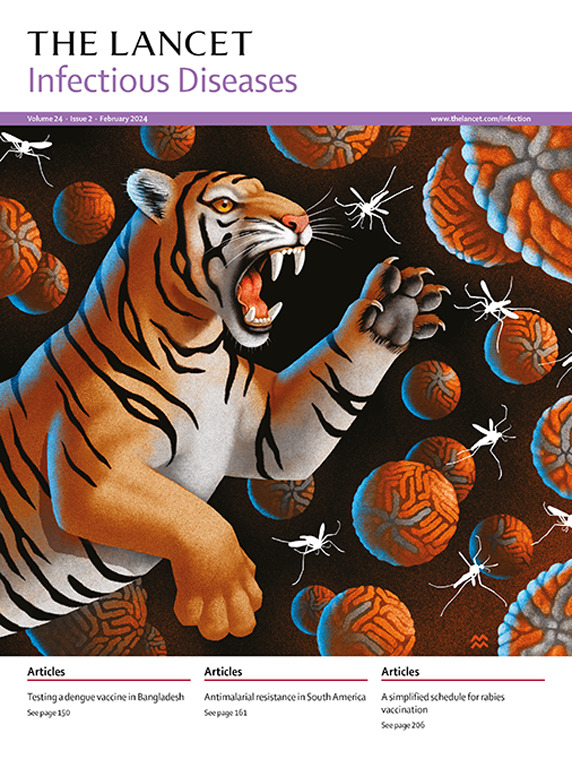The spatiotemporal ecology of Oropouche virus across Latin America: a multidisciplinary, laboratory-based, modelling study
IF 36.4
1区 医学
Q1 INFECTIOUS DISEASES
引用次数: 0
Abstract
Background
Latin America has been experiencing an Oropouche virus (OROV) outbreak of unprecedented magnitude and spread since 2023–24 for unknown reasons. We aimed to identify risk predictors of and areas at risk for OROV transmission.Methods
In this multidisciplinary, laboratory-based, modelling study, we retrospectively tested anonymised serum samples collected between 2001 and 2022 for studies on virus epidemiology and medical diagnostics in Bolivia, Brazil, Colombia, Costa Rica, Ecuador, and Peru with nucleoprotein-based commercial ELISAs for OROV-specific IgG and IgM antibodies. Serum samples positive for IgG from different ecological regions and sampling years were tested against Guaroa virus and two OROV glycoprotein reassortants (Iquitos virus and Madre de Dios virus) via plaque reduction neutralisation testing (PRNT) to validate IgG ELISA specificity and support antigenic cartography. Three OROV strains were included in the neutralisation testing, a Cuban OROV isolate from the 2023–24 outbreak, a contemporary Peruvian OROV isolate taken from a patient in 2020, and a historical OROV isolate from Brazil. We analysed the serological data alongside age, sex, cohort, and geographical residence data for the serum samples; reported OROV incidence data; and vector occurrence data to explore OROV transmission in ecologically different regions of Latin America. We used the MaxEnt machine learning methodology to spatially analyse and predict OROV infection risk across Latin America, fitting one model with presence–absence serological data (seropositive results were recorded as presence and seronegative results were recorded as absence) and one model with presence-only, reported incidence data from 2024. We computed marginal dependency plots, variable contribution, and permutation metrics to analyse the impact of socioecological predictors and fitted a generalised linear mixed-effects model with logit link and binary error structure to analyse the potential effects of age, sex, or cohort type bias and interactions between age or sex and cohort type in our serological data. We conducted antigenic cartography and evolutionary characterisations of all available genomic sequences for all three OROV genome segments from the National Center for Biotechnology Information, including branch-specific selection pressure analysis and the construction of OROV phylogenetic trees.Findings
In total, 9420 serum samples were included in this study, representing 76 provinces in the six Latin American countries previously mentioned. The sex distribution across the combined cohorts was 48% female (4237 of 8910 samples with available data) and 52% male (4673 of 8910 samples) and the mean age was 29·5 years (range 0–95 years). The samples were collected from census-based cohorts, cohorts of healthy individuals, and cohorts of febrile patients receiving routine health care. The average OROV IgG antibody detection rate was 6·3% (95% CI 5·8–6·8), with substantial regional heterogeneity. The presence–absence, serology-based model predicted high-risk areas for OROV transmission in the Amazon River basin, around the coastal and southern areas of Brazil, and in parts of central America and the Caribbean islands, consistent with case data from the 2023–24 outbreak reported by the Pan American Health Organization. Areas with a high predicted risk of OROV transmission with the serology-based model showed a statistically significant positive correlation with state-level incidence rates per 100 000 people in 2024 (generalised linear model, p=0·0003). The area under the curve estimates were 0·79 (95% CI 0·78–0·80) for the serology-based model and 0·66 (95% CI 0·65–0·66) for the presence-only incidence-based model. Longitudinal diagnostic testing of serum samples from cohorts of febrile patients suggested constant circulation of OROV in endemic regions at varying intensity. Climate variables accounted for more than 60% of variable contribution in both the serology-based and incidence-based models. Antigenic cartography, evolutionary analyses, and in-vitro growth comparisons showed clear differentiation between OROV and its glycoprotein reassortants, but not between the three different OROV strains. PRNT titres of OROV-neutralising serum samples were strongly correlated between all three tested OROV isolates (r>0·83; p<0·0001) but were not correlated with the two glycoprotein reassortants.Interpretation
Our data suggest that climatic factors are major drivers of OROV spread and were potentially exacerbated during 2024 by extreme weather events. OROV glycoprotein reassortants, but not individual OROV strains, probably have distinct antigenicity. Preparedness for OROV outbreaks requires enhanced diagnostics, surveillance, and vector control in current and future endemic areas, which could all be informed by the risk predictions presented in this Article.Funding
European Union.Translations
For the Spanish and Portuguese translations of the abstract see Supplementary Materials section.整个拉丁美洲欧罗波切病毒的时空生态:一项多学科、基于实验室的建模研究
自2023 - 2024年以来,拉丁美洲一直在经历前所未有的规模和传播的Oropouche病毒(OROV),原因不明。我们的目的是确定OROV传播的风险预测因素和风险区域。方法在这项多学科、基于实验室的建模研究中,我们对2001年至2022年间收集的玻利维亚、巴西、哥伦比亚、哥斯达黎加、厄瓜多尔和秘鲁的匿名血清样本进行回顾性检测,使用基于核蛋白的orov特异性IgG和IgM抗体商业elisa检测病毒流行病学和医学诊断。采用血小板减少中和试验(PRNT)对不同生态区域和采样年份的血清IgG阳性样本进行瓜罗阿病毒和两种OROV糖蛋白重组体(伊基托斯病毒和马德雷·德·Dios病毒)的检测,验证IgG ELISA特异性,支持抗原制图。中和试验包括三株OROV菌株,一株来自2023-24年暴发的古巴OROV分离株,一株来自2020年从一名患者身上提取的当代秘鲁OROV分离株,以及一株来自巴西的历史OROV分离株。我们分析了血清样本的血清学数据以及年龄、性别、队列和地理居住地数据;报告的OROV发病率数据;和媒介发生数据,探索OROV在拉丁美洲不同生态区域的传播。我们使用MaxEnt机器学习方法对整个拉丁美洲的OROV感染风险进行空间分析和预测,将一个模型与存在-不存在血清学数据(血清阳性结果记录为存在,血清阴性结果记录为不存在)拟合,另一个模型与仅存在的2024年报告的发病率数据拟合。我们计算了边际依赖图、变量贡献和排列度量来分析社会生态预测因子的影响,并拟合了一个具有logit链接和二元误差结构的广义线性混合效应模型,以分析血清学数据中年龄、性别或队列类型偏差的潜在影响,以及年龄或性别与队列类型之间的相互作用。我们对来自国家生物技术信息中心的所有三个OROV基因组片段的所有可用基因组序列进行了抗原制图和进化特征分析,包括分支特异性选择压力分析和OROV系统发育树的构建。本研究共纳入9420份血清样本,代表上述6个拉丁美洲国家的76个省。合并队列的性别分布为女性48%(有数据的8910个样本中有4237个),男性52%(8910个样本中有4673个),平均年龄为29.5岁(范围0-95岁)。样本从基于普查的队列、健康个体队列和接受常规卫生保健的发热患者队列中收集。平均OROV IgG抗体检出率为6.3% (95% CI为5.8 ~ 6.8),存在较大的区域异质性。基于血清学的有无模型预测了亚马逊河流域、巴西沿海和南部地区以及中美洲和加勒比岛屿部分地区的OROV传播高风险地区,这与泛美卫生组织报告的2023-24年暴发的病例数据一致。基于血清学模型的OROV传播预测高风险地区与2024年国家级每10万人发病率呈显著正相关(广义线性模型,p= 0.0003)。以血清学为基础的模型曲线下估计面积为0.79 (95% CI 0.78 - 0.80),仅以发病率为基础的模型曲线下估计面积为0.66 (95% CI 0.65 - 0.66)。对发热患者队列血清样本的纵向诊断测试表明,在流行地区,OROV以不同的强度持续传播。在基于血清学和基于发病率的模型中,气候变量占变量贡献的60%以上。抗原制图、进化分析和体外生长比较显示OROV及其糖蛋白重组体之间存在明显差异,但三种不同OROV菌株之间没有明显差异。OROV中和血清样品的PRNT滴度在所有三个测试的OROV分离株之间呈强相关(r> 0.83;P< 0.0001),但与两种糖蛋白重组无关。我们的数据表明,气候因素是OROV传播的主要驱动因素,并且在2024年可能被极端天气事件加剧。OROV糖蛋白重组体,而不是单个的OROV菌株,可能具有不同的抗原性。对OROV暴发的准备需要在当前和未来的流行地区加强诊断、监测和媒介控制,这都可以通过本文提出的风险预测来提供信息。FundingEuropean联盟。 有关摘要的西班牙语和葡萄牙语翻译,请参阅补充资料部分。
本文章由计算机程序翻译,如有差异,请以英文原文为准。
求助全文
约1分钟内获得全文
求助全文
来源期刊

Lancet Infectious Diseases
医学-传染病学
CiteScore
60.90
自引率
0.70%
发文量
1064
审稿时长
6-12 weeks
期刊介绍:
The Lancet Infectious Diseases was launched in August, 2001, and is a lively monthly journal of original research, review, opinion, and news covering international issues relevant to clinical infectious diseases specialists worldwide.The infectious diseases journal aims to be a world-leading publication, featuring original research that advocates change or sheds light on clinical practices related to infectious diseases. The journal prioritizes articles with the potential to impact clinical practice or influence perspectives. Content covers a wide range of topics, including anti-infective therapy and immunization, bacterial, viral, fungal, and parasitic infections, emerging infectious diseases, HIV/AIDS, malaria, tuberculosis, mycobacterial infections, infection control, infectious diseases epidemiology, neglected tropical diseases, and travel medicine. Informative reviews on any subject linked to infectious diseases and human health are also welcomed.
 求助内容:
求助内容: 应助结果提醒方式:
应助结果提醒方式:


